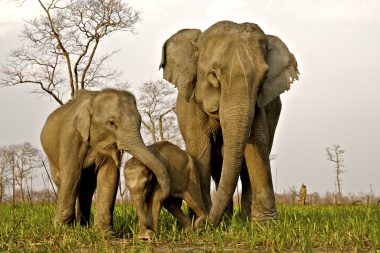India’s Kaziranga National Park is located between the Brahmaputra River in the north and National Route 37 in the south, in the state of Assam. The area of about 919 km² consists mainly of swamps, forests and tall grasslands. Since 1985, the Kaziranga National Park has been a UNESCO World Heritage Site, since 2005 it has been an elephant reserve and since 2007 an official tiger reserve.
These large wild animals can almost only be found here
In Asia, too, wild animals suffer from hunting and the destruction of their habitat. This makes shelters such as the Kaziranga National Park all the more important. For visitors, large animals are usually the most interesting. In Kaziranga you will find five impressive species.
About 65% of all Indian rhinoceroses still in existence live here. This makes this national park the most important protected area for the endangered Indian rhinoceros (Rhinoceros unicornis), also known as the Indian rhinoceros or unicorned rhinoceros. Unfortunately, it is also threatened by poaching in the national park, as its horn is in high demand in traditional Chinese medicine.
Also threatened by poaching because of its tusks is the Asian elephant (Elephas maximus), for which this national park is also an important protected area. Encountering a herd of these second largest land animals in the world is an unforgettably impressive experience, which is quite possible in Kaziranga.
The Bengal tiger (Panthera tigris tigris), also known as the king tiger or Indian tiger, is also one of the five large animal species that find a protected habitat in this national park. Unfortunately, this is sorely needed, as there are only about 2,500 of these beautiful animals left in the wild. With a bit of luck, you can observe one of these rare animals on a jeep safari through the national park.
The grouper deer (Rucervus) or Barasingha is an Indian deer species that stands out for its angular antlers, often bearing 12 to 14 ends. The populations of this deer, which lives near wetlands, are endangered outside the national park due to habitat destruction and infection with diseases of domestic animals.
The fifth large animal species is the wild water buffalo. Although water buffalo are widespread as farm animals in Asia, the wild conspecifics have now become very rare.
Other animals and plants of the Kaziranga National Park
In this national park you will encounter numerous animal and plant species, some of which can only be found there. Of the approximately 35 mammal species, 15 are considered endangered species. The park is also home to 27 species of reptiles, 9 different amphibians, 29 species of fish and 500 species of birds. In addition, there are over 540 plant species, including lotus flowers, water lilies and water hyacinths. So there is a lot to discover in Kaziranga.
The origin and development of Kaziranga National Park

The beginnings of the park date back to 1905 and on the initiative of the then English Viceroy, Lord Curzon. In 1908, a core area was designated as a forest nature reserve. In 1916 it became a game reserve. It was not until 1938 that the first visitors were admitted. In 1947, India became independent from England and in 1950 the Indian state declared the area a nature reserve. At that time, the area had a size of 430 km². In February 1974, the area received the status of a national park. Since 1997, the park has been slowly but steadily enlarged by land purchases on the outskirts.
How to get to Kaziranga National Park
By plane, you can fly either to Jorhat, 96 km away, or to Tezpur Airport, which is just under 60 km away. From there, you can continue by rental car, taxi or bus to the national park. The nearest train station is Furkating Junction, about a 2-hour drive from the park.
What is the best time of year to visit Kaziranga National Park?
From July to October there is a rainy season in this area. The Brahmaputra then floods part of the park and many animals leave the area. On the other hand, there is almost no rain between November and April. The animals then returned to the park. This is the best time to go on a successful safari through the national park.
How to visit Kaziranga National Park
Because of the tigers living freely in the national park, no hikes can be made through the park. That would be far too dangerous. It is also forbidden to enter the park without a guide. In the months of November to April, however, various guided safaris are offered – with jeeps or on elephants. If you want to observe elephants and rhinos, you should book a safari that starts at dawn. There are observation towers scattered throughout the park from which you can get a good view of the park’s wildlife. In the information centre of the national park, visitors can find out about the park and nature and wildlife protection.


